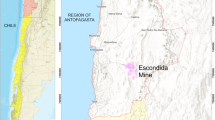Abstract
Modeling of geometallurgical variables is becoming increasingly important for improved management of mineral resources. Mineral processing circuits are complex and depend on the interaction of a large number of properties of the ore feed. At the Olympic Dam mine in South Australia, plant performance variables of interest include the recovery of Cu and U3O8, acid consumption, net recovery, drop weight index, and bond mill work index. There are an insufficient number of pilot plant trials (841) to consider direct three-dimensional spatial modeling for the entire deposit. The more extensively sampled head grades, mineral associations, grain sizes, and mineralogy variables are modeled and used to predict plant performance. A two-stage linear regression model of the available data is developed and provides a predictive model with correlations to the plant performance variables ranging from 0.65–0.90. There are a total of 204 variables that have sufficient sampling to be considered in this regression model. After developing the relationships between the 204 input variables and the six performance variables, the input variables are simulated with sequential Gaussian simulation and used to generate models of recovery of Cu and U3O8, acid consumption, net recovery, drop weight index, and bond mill work index. These final models are suitable for mine and plant optimization.














Similar content being viewed by others
References
Almeida AS, Journel AG (1994) Joint simulation of multiple variables with a Markov type coregionalization model. Math Geol 26:565–588
Babak O, Deutsch CV (2009a) Improved spatial modeling by merging multiple secondary data for intrinsic collocated cokriging. J Pet Sci Eng 69:93–99
Babak O, Deutsch CV (2009b) Collocated cokriging based on merged secondary attributes. Math Geosci 41:921–926
Bailey T, Krzanowski W (2012) An overview of approaches to the analysis and modeling of multivariate geostatistical data. Math Geosci 44:381–393
Breiman L, Friedman J (1985) Estimating optimal transformations for multiple regression and correlation. J Am Stat Assoc 80(391):580–598
Desbarats AJ, Dimitrakopoulos R (2000) Geostatistical simulation of regionalized pore size distributions using min/max autocorrelations factors. Math Geol 32:919–942
Emery X (2012) Co-simulating total and soluble copper grades in an oxide ore deposit. Math Geosci 44:27–46
Enders C (2010) Applied missing data analysis. Guilford, New York, 377 pp
Filzmoser P (1999) Robust principal component and factor analysis in the geostatistical treatment of environmental data. Environmetrics 10:363–375
Hong S (2010) Multivariate analysis of diverse data for improved geostatistical reservoir modeling. PhD, University of Alberta, Canada, 188 pp
Hotelling H (1933) Analysis of a complex of statistical variables into principal components. J Educ Psychol 24:417–441
Johnson RJ, Wichern DW (1998) Applied multivariate statistical analysis, 4th edn. Prentice Hall, Upper Sadde River, 816 pp
Leuangthong O, Deutsch CV (2003) Stepwise conditional transformation for simulation of multiple variables. Math Geol 35:155–173
Mueller UA, Ferreira J (2012) The U-WEDGE transformation method for multivariate geostatistical simulation. Math Geosci 44:427–448
Pawlowsky-Glahn V, Buccianti A (2011) Compositional data analysis: theory and applications. Wiley, Chichester, 400 pp
Rivoirard J (2001) Which models for collocated cokriging? Math Geol 33:117–131
Scott DW (1992) Multivariate density estimation: theory, practice, and visualization. Wiley, New York, 376 pp
Switzer P, Green A (1984) Min/Max autocorrelation factors for multivariate spatial imaging. Technical Report 6, Stanford University, Department of Statistics, 14 pp
Acknowledgements
We would like to thank BHP Billiton for providing the data used for this study.
Author information
Authors and Affiliations
Corresponding author
Rights and permissions
About this article
Cite this article
Boisvert, J.B., Rossi, M.E., Ehrig, K. et al. Geometallurgical Modeling at Olympic Dam Mine, South Australia. Math Geosci 45, 901–925 (2013). https://doi.org/10.1007/s11004-013-9462-5
Received:
Accepted:
Published:
Issue Date:
DOI: https://doi.org/10.1007/s11004-013-9462-5



